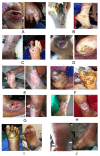Various Types of Wounds That Diabetic Patients Can Develop: A Narrative Review
- PMID: 37830052
- PMCID: PMC10566271
- DOI: 10.1177/2632010X231205366
Various Types of Wounds That Diabetic Patients Can Develop: A Narrative Review
Abstract
Diabetic foot complications represent a substantial health burden and are the foremost cause of hospitalization in patients with diabetes. Diabetes mellitus (DM) is known to cause several other problems. Diabetes is rapidly becoming the leading cause of illness and death worldwide. Diabetic foot ulcers (DFU) are one of the most painful complications of diabetes. These complications cause problems in blood vessels, nerves, and other organs throughout the body. DFU pathophysiology is attributed to a triad of neuropathies, trauma with secondary infection, and arterial occlusive disease. This review aims to identify the types of wounds that diabetics can develop. Owing to the complexity of their disease pathology, diabetics are susceptible to a variety of wounds, such as diabetic ulcers due to trauma (DUDT); neuropathic, ischemic, neuroischemic, arterial, venous, and mixed wounds; and diabetic bullae, furuncles, cellulitis, and carbuncles. Therefore, it is essential for healthcare providers to recognize the specific classification of a diabetic wound based on its distinctive attributes to provide appropriate wound care and therapeutic interventions. In the context of individuals with diabetes, it is of paramount significance to precisely identify the types of wounds during the initial evaluation to provide appropriate care and treatment, thereby enhancing the probability of favorable outcomes.
Keywords: DUDT; Diabetic wounds; arterial; ischemic; neuroischemic; neuropathic; venous.
© The Author(s) 2023.
Conflict of interest statement
The author declared no potential conflicts of interest with respect to the research, authorship, and/or publication of this article.
Figures
Similar articles
-
Poorly designed research does not help clarify the role of hyperbaric oxygen in the treatment of chronic diabetic foot ulcers.Diving Hyperb Med. 2016 Sep;46(3):133-134. Diving Hyperb Med. 2016. PMID: 27723012
-
Determinants and estimation of healing times in diabetic foot ulcers.J Diabetes Complications. 2002 Sep-Oct;16(5):327-32. doi: 10.1016/s1056-8727(01)00217-3. J Diabetes Complications. 2002. PMID: 12200075
-
Bacterial population of chronic crural ulcers: is there a difference between the diabetic, the venous, and the arterial ulcer?Vasa. 2000 Feb;29(1):62-70. doi: 10.1024/0301-1526.29.1.62. Vasa. 2000. PMID: 10731891
-
Emerging evidence for neuroischemic diabetic foot ulcers: model of care and how to adapt practice.Int J Low Extrem Wounds. 2009 Jun;8(2):82-94. doi: 10.1177/1534734609336948. Int J Low Extrem Wounds. 2009. PMID: 19443897 Review.
-
Reappraising Diabetic Foot Ulcers: A Focus on Mechanisms of Ulceration and Clinical Evaluation.Int J Low Extrem Wounds. 2022 Sep;21(3):294-302. doi: 10.1177/1534734620944514. Epub 2020 Jul 31. Int J Low Extrem Wounds. 2022. PMID: 32734837 Review.
Cited by
-
Effect of Treatment of Neuropathic and Ischemic Diabetic Foot Ulcers with the Use of Local Ozone Therapy Procedures-An Observational Single Center Study.Clin Pract. 2024 Oct 16;14(5):2139-2150. doi: 10.3390/clinpract14050169. Clin Pract. 2024. PMID: 39451884 Free PMC article.
-
Novel Therapeutic Hybrid Systems Using Hydrogels and Nanotechnology: A Focus on Nanoemulgels for the Treatment of Skin Diseases.Gels. 2024 Jan 6;10(1):45. doi: 10.3390/gels10010045. Gels. 2024. PMID: 38247768 Free PMC article. Review.
-
Nitric oxide-based treatments improve wound healing associated with diabetes mellitus.Med Gas Res. 2025 Mar 1;15(1):23-35. doi: 10.4103/mgr.MEDGASRES-D-24-00020. Epub 2024 Jul 25. Med Gas Res. 2025. PMID: 39436167 Free PMC article. Review.
-
Advancements in diabetic foot ulcer research: Focus on mesenchymal stem cells and their exosomes.Heliyon. 2024 Aug 29;10(17):e37031. doi: 10.1016/j.heliyon.2024.e37031. eCollection 2024 Sep 15. Heliyon. 2024. PMID: 39286219 Free PMC article. Review.
-
Laparoscopic versus open lumbar sympathectomy in critical limb threatening ischemia patients in Egypt.BMC Surg. 2024 Nov 7;24(1):350. doi: 10.1186/s12893-024-02618-6. BMC Surg. 2024. PMID: 39511575 Free PMC article. Clinical Trial.
References
-
- Rosyid FN. Etiology, pathophysiology, diagnosis and management of diabetics’ foot ulcer. Int J Res Med Sci. 2017;5:4206-4213.
-
- Agale SV. Chronic leg ulcers: Epidemiology, aetiopathogenesis, and management. Ulcers. 2013;2013:4136041-4136049.
Publication types
LinkOut - more resources
Full Text Sources


